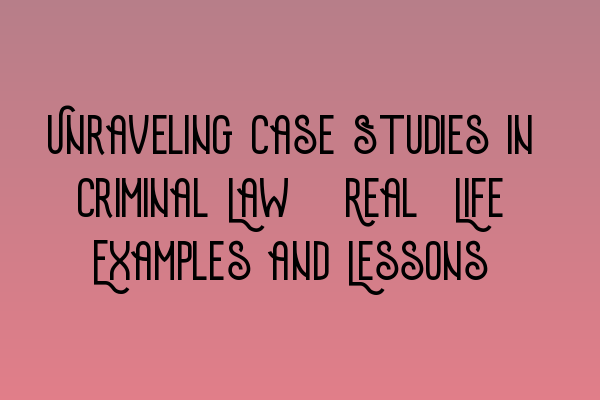Sure, here’s the blog post:
—
Unraveling Case Studies in Criminal Law: Real-Life Examples and Lessons
Welcome to SQE Criminal Law & Practice Law UK, where we delve into the fascinating world of criminal law. Today, we are going to explore real-life case studies that have shaped the landscape of criminal law and learn valuable lessons from them. From high-profile trials to lesser-known incidents, these examples will help us understand the complexities and nuances of the legal system.
1. The O.J. Simpson Trial
One of the most infamous criminal trials in history, the O.J. Simpson case captivated the nation’s attention in the mid-1990s. Simpson, a former American football player, was accused of murdering his ex-wife Nicole Brown Simpson and her friend Ron Goldman. This trial showcased the power of forensic evidence and the significance of celebrity status in criminal proceedings.
Lessons learned: The O.J. Simpson trial highlighted the importance of proper handling and analysis of forensic evidence. It also shed light on the role that fame and public perception can play in the criminal justice system.
2. The Central Park Five
In the late 1980s, five teenagers from Harlem were wrongfully convicted of raping a woman in Central Park, New York City. The case became a symbol of racial injustice and flaws in the criminal justice system. Years later, DNA evidence exonerated the five men, highlighting the potential for wrongful convictions and the need for reform.
Lessons learned: The Central Park Five case taught us that wrongful convictions can occur, emphasizing the importance of fair investigations, thorough evidence examination, and a robust legal defense.
3. The Amanda Knox Case
The Amanda Knox case, also known as the Perugia murder trial, involved an American exchange student who was accused, along with her then-boyfriend, of murdering her roommate in Italy. This case attracted worldwide media attention and raised questions about cultural differences in criminal justice systems and the role of public opinion in legal proceedings.
Lessons learned: The Amanda Knox case demonstrated the impact of media coverage and public perception on criminal trials. It also highlighted the need for international cooperation and understanding in complex cross-border cases.
4. The Stephen Lawrence Case
The Stephen Lawrence case, a racially motivated murder in London in 1993, exposed institutional racism within the British police force. It took nearly two decades for justice to be served, as the original investigation was marred by mishandling and prejudice. This case led to significant reforms in the UK criminal justice system.
Lessons learned: The Stephen Lawrence case brought attention to systemic issues like racism and the need for police accountability, leading to changes in police practices and procedures.
5. The Enron Scandal
The Enron scandal, a corporate fraud case in the early 2000s, revealed illegal accounting practices within one of the largest energy companies in the United States. The trials that followed brought corporate corruption to the forefront and resulted in significant regulatory changes to prevent similar occurrences in the future.
Lessons learned: The Enron scandal emphasized the importance of corporate accountability, the need for stricter financial regulations, and the role of criminal law in protecting the public from corporate misconduct.
Conclusion
These real-life case studies serve as reminders of the intricacies of criminal law and the impact it has on society. By examining these examples, we can learn valuable lessons about the importance of fair investigations, evidence examination, public perception, and broader societal issues. The study of criminal law goes beyond the courtroom, shaping legal systems and playing a crucial role in maintaining justice and integrity.
—
Please note that the above blog post contains HTML tags for styling purposes.
